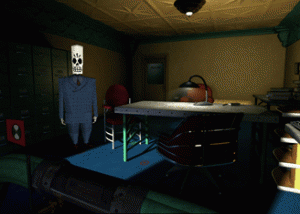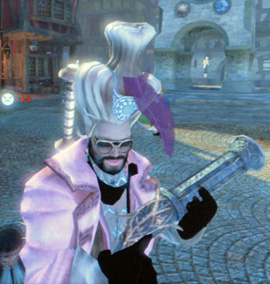![]() (Editor’s note: This article was originally published in the April 2009 issue of GameCola, back when GameCola was published in a monthly online magazine format.)
(Editor’s note: This article was originally published in the April 2009 issue of GameCola, back when GameCola was published in a monthly online magazine format.)
GameCola Headquarters
New Haven, CT 06511
April 2009
Dear Readers,
I hope you all enjoyed GameCola’s first-ever April Fool’s Day extravaganza! In case you missed it, GC writer Zach Rich took over GameCola.net, rechristened it “Zach Rich’s Slightly Carbonated Extravaganza for the Hard of Hearing,” fired all the other writers—including yours truly—and wrote an entire issue by himself.1 It was almost as good as the time I April Foolsed you all into thinking there would be a new Ghostbusters game. Boy, didn’t you feel silly, thinking there would really be a new Ghostbusters game.
Guess the joke’s on me, isn’t it? That’s actually a real trailer for a real Ghostbusters game that’s coming out this summer. No April Foolsin’.
You know, I’ve never been very good at transitions.
My column, Dear Readers, was always intended to be an opinion column. The only problem with this is that I don’t actually have any opinions, which is why this column tends to be less “this is how I feel about the videogame industry,” and more “this is what my face would look like if I were a monkey.” I believe the last time I expressed an actual opinion here was in June of 2006, when I stated that Grand Theft Auto, as a series, is boring. I hope to express similarly unpopular opinions with this month’s topic, which is: stupid things developers do that almost ruin their awesome games.
You know exactly the kind of thing I’m talking about, but in case you don’t, here’s an example: The controls in Grim Fandango. Grim Fandango was one of the last classic adventure games by genre juggernaut LucasArts. The game’s characters were memorable, its story compelling, and its puzzles engaging. The only thing it got wrong was the controls. For some godforsaken reason,  Grim Fandango decided not to use the classic point-and-click interface that makes these games what they are, instead opting for a generic direct-control-of-the-character scheme that actively works against you. Playing this game is like trying to wrestle a gator, and you’re lucky if your character ever does what you intend for him to do. Most of the time he just bumps into walls, spins around a little, and bumps into more walls. It nearly makes the game unplayable.
Grim Fandango decided not to use the classic point-and-click interface that makes these games what they are, instead opting for a generic direct-control-of-the-character scheme that actively works against you. Playing this game is like trying to wrestle a gator, and you’re lucky if your character ever does what you intend for him to do. Most of the time he just bumps into walls, spins around a little, and bumps into more walls. It nearly makes the game unplayable.
That’s the sort of thing I’m talking about—incredibly stupid, and incredibly avoidable, design flaws that prevent a great game from being totally awesome, or, in some cases, prevent the game from being any fun at all.
Now that I’ve provided an example that we can all agree on, I’ll move on to the one that’ll make you throw rocks at me: Fable II.
Specifically, I’m talking about Fable II’s online co-op mode. The back of the game’s box makes it sound neato: “Dynamic co-op play allows friends and family to join your game at any time, and share your world.” But what isn’t clear is how completely literally you’re supposed to be taking that.
Your friend doesn’t get to play as his own character—he only gets to play as a generic person generated specifically for your game. If he ends up liking this character, too bad, because he looses it as soon as he quits the game. Your friend also doesn’t get to keep any of the new items or weapons he finds, though he probably won’t find that many anyway, since he isn’t allowed to interact with any of the merchants, or anyone else, for that matter. He also doesn’t get credit for completing any of the quests—well, of course he doesn’t, since he doesn’t have a real character. Instead of you and a friend joining forces to conquer the game, your friend joins your game to help you finish your quests. I bet you feel selfish just reading that sentence.

The only good part is that, if you earn any Achievements, your friend does as well. Also, your friend gets to take any gold and XP he earns and apply it to his own character.
It’s a severely limited mode that isn’t so much “co-op” as it is “help me beat Fable II, friend, since I’m terrible at videogames.” I think the developer was thinking that, since this is a single-player game, and the quests are all meant for one player, it doesn’t make sense for two different characters to be working through them simultaneously. But they already took one step in that direction by letting another player join your game and help you complete them. Why not let that person use his own character? Why not let him show off his character to his friend, find some super-cool items, and get credit for completing quests, side-by-side with his buddy? Why not let two people create their own characters and then join together to complete the quests? Maybe, for story purposes, one person can be the “main” player and one person can just tag along. Can’t that person still be an actual participant, instead of a shadow?
It’s not like the idea of a real co-op action-RPG is so out there. Champions of Norrath? Baldur’s Gate: Dark Alliance? Secret of Mana? It can be loads of fun; why not take the time to do it right? Why even bother including a co-op mode in your game when Dave the intern only slapped it together during his lunch break because he had no friends to eat with and nothing better to do?
It doesn’t bring down the whole game, considering how excellent the actual gameplay is, and how awesome your dog companion is, but it does bring down the overall quality of the game—after all, the entire package would be much better if they’d just cut out the terrible co-op mode.
And don’t even get me started on the issues I have with the characters’ clothing,4or the DLC.5 Or that damn monk woman that joins your party.6
Are you still reading? I don’t think I would be—this article is already too long, and I still have, according to my list, 13 games that I want to talk about. So, you know what? Instead of writing a way-too-long article that nobody but my mom will read, let’s go ahead and call this “Part 1” of a multi-part look at the stupid things developers do that almost ruin their awesome games.
While you’re waiting for Part 2, why not read the new issue of GameCola? Here’s what you have to look forward to:
- In addition to his regular Inside the Guide and The Ten Reasons columns, and his review of Emerald City Confidential, Michael Gray dusts off two old-school GameCola columns to bring us:
- Carbonated News, in which he talks about all the big happenings from the Game Developers Conference, and
- Oh, the Humanity!, in which he discusses a Phoenix Wright manga.
- Two Versus Mode all-stars duke it out in Versus Mode, as Captain Eric Regan makes his seventh appearance in the column, and former GameCola staff writer Christian Porter makes his sixth. I’m not going to research this, or anything, but I believe they’ve written for Versus Mode more than anyone else.
- Speaking of all-stars, a world-famous celebrity joins this month’s podcasts: me!
- Also, you should read testgame this month. That’s all I’m sayin’.
- In his review this month, Nathaniel Hoover compares Mega Man to pizza.
- In his review this month, Meteo discusses and rates 46 games at once.
- Mid-Boss wrote something, but he wrote it way ahead of time, and I’m writing this way late, so I don’t remember what he talked about.
- And, finally, Vangie and Matt ask deep questions in their columns.
Of course, by “finally,” I don’t actually mean “finally,” since we have plenty of other great articles this month that didn’t get super special bullet points. You should read those articles, too. Especially The Gates of Life.
Enjoy the issue!
Paul Franzen
editor in chief
e-mail: pfranzen@gamecola.net
1. I call it an “April Fools extravaganza,” but for all you know, I’m only trying to cover up for the fact that he actually did take over GameCola for two days.
2. In case you’re wondering, this, BioShock 2, and Punch-Out!! are the only games worth looking forward to in 2009.3
3. In fact, you could say that Punch-Out!! and the others will be duking it out for the Game of the Year 2009 award.
4. Fable II does something fantastic with your character’s clothing selection: what you wear has absolutely no impact in battle. In most games that let you play dress up with your main character—think Fallout 3—there’s plenty of clothing options, but it’s all a ruse, since there’s only a few things you can wear and not immediately die in battle because your defense is too low. Fable II doesn’t do that. The only in-game impact clothing has is on how attractive your character your is to NPCs, meaning you can actually wear anything you want.
The only problem is that you barely have any options. Almost every article of clothing in the entire game is available in the first town. There are plenty of other towns to visit, but they don’t offer many more options. That’s the first issue for anyone who’d like to update their wardrobe as the game progresses. Strike two is that clothing options are further incredibly limited, as there are only a few different types of shirts, pants, hats, etc.
Fable II did something crazy awesome in letting you actually wear all the neat stuff you find…but then they forgot to actually let you find neat stuff. What a crock.
5. What a crock. The whole DLC just has you doing the same quest over, and over, and over again, four times in total. And one of the shops lets you purchase cosmetic potions that basically negate another of the game’s selling points—that your character’s appearance at the end of the game reflects how you played the game. Upset that you’re now an old fart? Don’t worry; you can remove those wrinkles! Don’t like that you ate too much pie, and now you’re a fatty? There’s a potion to take care of that, too. Nothing says you have to buy the potions, of course, but it shouldn’t even be an option in a game that emphasizes personal responsibility and the impact of your decisions.
